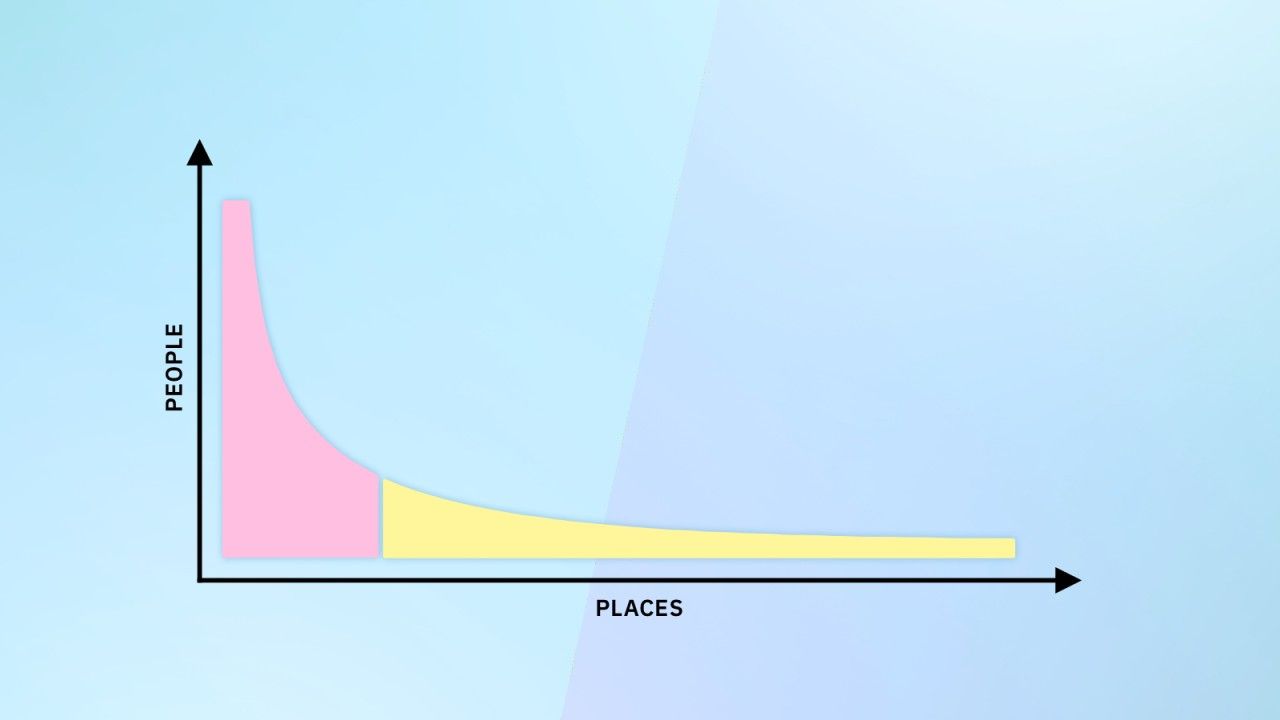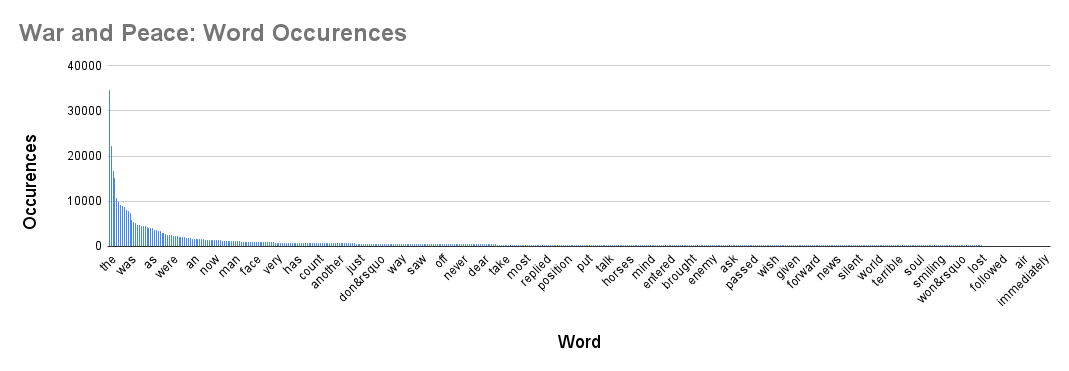Remote Work and The Urban Long Tail


In 1949, the American linguist George Kingsley Zipf published a curious study. Zipf analyzed various long texts and created a ranking of words based on how often they appeared in a given work. He found that the frequency in which a word appears in a text is proportional to the inverse of its rank: The second most common word in a book appears approximately 1/2 as many times as the most common one; the third most common word appears 1/3 as many times, etc.
Take Tolstoy's War and Peace, for example. Below is a chart showing the occurrence of the 500 most frequent words in the book. The most common word, "the," appears 34,738 times. The second most common word, "and," appears 22,297 times or close to half the times as the first. The 14th most common word, "had," appears less than 1/10 of the times as "the." And so on. The frequency of words diminishes in a relatively ordered fashion.

Plotting the words on a chart results in a familiar shape — a power-law distribution with a tall head and a long tail. Over time, researchers found that many other data series display similar characteristics — ranking the size of cities, the size and income of firms, the popularity of websites, the popularity of songs, and more.
Scientists are still trying to explain why such power-law distributions emerge. One of the most common explanations came from Zipf himself. "Every individual’s movement, of whatever sort," said Zipf, "tend to be governed by one single primary principle... the Principle of Least Effort." By "movement," Zipf refers to any type of human decision or action. In every situation, humans will seek the path of least effort. As a result, they will constantly reuse and revisit words and places.
In the world of linguistics, this means that people will gravitate toward the most common words rather than use all the alternatives at their disposal. They will do so because the most common word is most likely to be understood by their audience — even if an alternative word might be more specific or accurate for what they're trying to describe.
In the world of cities, the Principle of Least Effort means people will gravitate toward the most popular destinations rather than visit others. They will do so because in the most common places are most likely to find what they're looking for (a good meal, a date, a nice view) — even if they could find an ideal view, meal, or date somewhere else. And as far as work is concerned, firms will gravitate towards large cities because that's where they're most likely to find the highest number of adequate employees.
There are other explanations for why so many natural and man-made interactions result in power-law distributions (and why firms choose to agglomerate in cities). We'll leave these to another time. For now, let's take Zipf's Principle of Least Effort and consider what it predicts for cities in a world of remote work.
In a world of in-person work, the path of least effort leads employers to the largest cities. In a world of remote work, the path of least effort leads companies to hire from anywhere. The practical implications of this dynamic are quite surprising.
In July 2020, during the first Covid lockdowns, I relied on Zipf's Law and speculated that if people could truly work anywhere, they would end up working from a much larger number of locations. I compared the world of work to the world of music and videos and looked at what happened after the transition from the constrained world of TV stations and record stores to the world of infinite videos and tracks on YouTube and Spotify:
"People's choice of location will likely become as specialized as their choice of other abundant goods such as songs or YouTube videos. In other words, population and economic activity will spread across a long tail of different locations.
This will not happen only between cities but also within cities. Between cities, it will mean that a variety of small towns and villages will get a little busier and that whole new towns and villages will be established. Within cities, it will mean that a variety of employment areas will pop up and save everyone the trouble of commuting to a central business or entertainment district or of competing to live next to a handful of good schools."
This is now a reality. Employees in the most competitive firms are now spread across many more locations. And office spaces are popping up in new places — closer to people's homes — in metro areas from New York to Tokyo.
But this process does not mean that the largest cities will become smaller. It only means they will become secondary to a new giant city in the cloud. "Remote" will be the most popular destination on earth. But real cities will be right behind it on the list (far behind, but still, second only to the global remote market).
And it gets even better for cities. When music and videos went online, they didn't just "develop" a longer tail but also a taller head. As Spotify's former Chief Economist, Will Page, points out, the most popular songs today are relatively more popular than ever — they draw a higher share of overall listens than ever before. In 2022, Spotify has more than 80 million songs, about 30 times more than the most popular streaming service had in 2004 and much much more than the largest physical record store even had. So, listeners have more choices and they exercise more of their choice. At the same time, less than 1% of the songs on streaming services now account for about 90% of all streams.
To put it differently, music lovers have more options, and their choice is more concentrated than ever before. Why are their choices more concentrated? Because in a world where consumers are overwhelmed with too many options, the path of least effort is even more attractive. This is not just true for consumers; it's also true for producers: Music and film producers keep recycling old hits and produce sequels, prequels, and spin-offs because these are the most likely to succeed.
What does this mean for cities? A few things:
- The overall talent pool will become larger than ever, as people from anywhere could join the global workforce and move to wherever they'd like to live (assuming they can do their job anywhere).
- The most popular destinations will become even more popular as both consumers (residents) and producers (investors and real estate developers) choose the path of least effort and converge into places that are already large.
- The most popular physical destinations will be relatively smaller than the largest destination — "remote," a place that doesn't exist but where many companies will choose to be located. However, in absolute terms, the largest physical cities will be much larger than they currently are because they'll now be able to attract many more people.
To elaborate on that last point, imagine NYC competing for a population in a global market where only 50 million people can practically pick up their things and move to the city. NYC is the most popular destination in this market. That's more or less the situation today.
Now, imagine that NYC is suddenly competing for population in a global market where 3 billion people can work remotely, and 500 million can practically pick up their things and move to the city. In such a world, "remote" will be the largest destination, but NYC can still attract many more people than it ever did.
And not just New York, any city that is already large and attractive stands to gain from this dynamic. But these cities will gain only if (1) they build enough housing and infrastructure to absorb this new demand and (2) their countries welcome skilled migrants from anywhere.
Two big ifs!
Best,


Dror Poleg Newsletter
Join the newsletter to receive the latest updates in your inbox.

